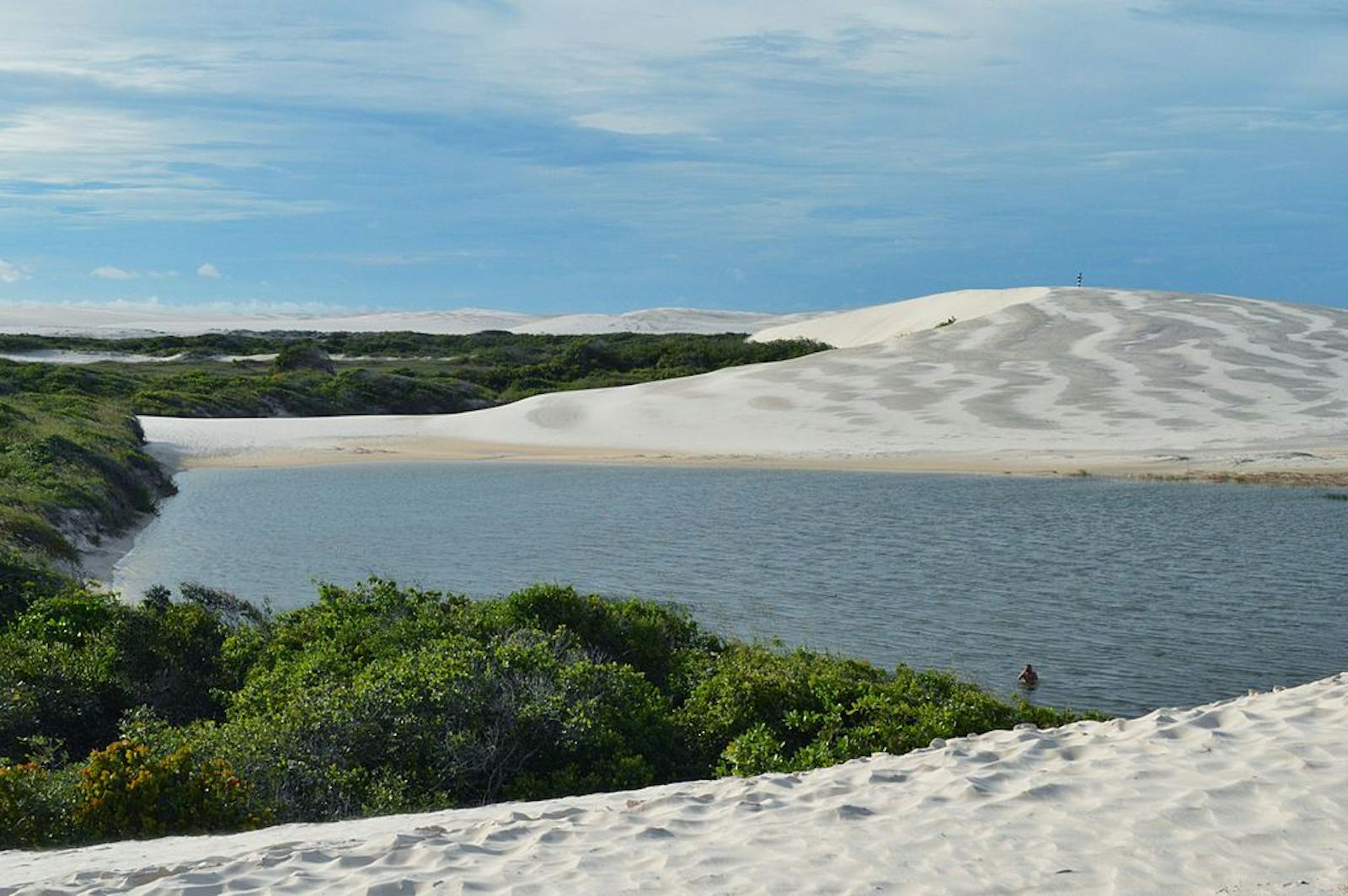Northeast Brazil Restingas
The ecoregion’s land area is provided in units of 1,000 hectares. The conservation target is the Global Safety Net (GSN1) area for the given ecoregion. The protection level indicates the percentage of the GSN goal that is currently protected on a scale of 0-10. N/A means data is not available at this time.
Bioregion: Amazon River Estuary (NT16)
Realm: Southern America
Ecoregion Size (1000 ha):
1,008
Ecoregion ID:
485
Conservation Target:
41%
Protection Level:
7
States: Brazil
The Northeastern Brazil Restingas are the most northern occurrence of this ecoregion type and are the most extensive and continuous of the Brazilian restingas. Much of the western portion of the ecoregion is protected by the Lencóis Maranhenses National Park, which contains some extraordinary dune-lake formations. The dunes are interspersed with lakes and lagoons which are ideal habitat for the scarlet ibis—a brilliantly pink bird with a long, curved bill, often visible from a great distance in the open dunes. It prefers to wade in the lagoons and tidal flats where it walks in the mud and sand using its feet to “scare up” some food.
.jpg)
The flagship species of the Northeast Brazil Restingas ecoregion is the scarlet ibis. Image credit: Ozz Hernandez, Creative Commons
The Northeastern Brazil Restingas extend approximately 400 km along a disjunct coastal strip, through the northern portions of the Brazilian states of Maranhão, Piauí, and Ceará. The western portion of this ecoregion abuts to the Maranhão mangroves of Bahía San José near the town of Primeira Cruz. This section extends inland for approximately 100 km to encompass most of the Rio Periá and its watershed.
The climate of this area is tropical maritime, hot and humid. The western portion of this ecoregion has three dry months between September and November), and is semi-humid in the east with 4–5 dry months (September - December). Precipitation can range from 1,000–1,500 mm, becoming slightly drier in the east. The mean annual temperature is 24°C with a winter mean of 22°C and a summer mean of 26°C.
Restingas are sand deposits of marine origin, which are laid down parallel to the sea shore and are anchored to rocky points or islands. The proximity to the Atlantic Ocean strongly influences dune formations that characterize and define this restinga habitat. The coastal section experiences high and prolonged winds, which results in frequent movement and migration of the dunes. This ecoregion is low lying, and elevations range from sea-level to 200 m. The coastal area experiences a great deal of sediment movement due to tides of approximately 6 m.
Vegetation in this ecoregion occurs in several distinct habitats. This dune vegetation is predominantly pioneer plants such as beach morning glory, seashore dropseed, and Iresine which are able to tolerate the constantly moving substrate. Riparian vegetation occurs along the numerous floodplains and is composed mainly of sedge and panic grass. Directly behind the dunes are shrublands characterized by the dwarf palm, and mixed with black Amazonian bird’s nest fern and other ferns. Further inland, away from sea winds, a low grainy restinga thicket occurs.
Along portions of the coastline, especially along the numerous bays and inlets, the restingas share elements with the Maranhão mangrove subecoregion, including true mangroves, grey mangrove, white mangrove, and button mangrove. Along the southwestern delineation, tropical moist forests become the dominant vegetation type and gradient for species, gradually becoming caatinga scrublands moving east.
This ecoregion is not characterized as harboring a high number of endemic species, as most vertebrate species that inhabit it are widespread. The most abundant vertebrates are those that take advantage of the aquatic environments (fresh and salt) among the sand dunes, including pelicans and many species of waterflow. The abundant sand beaches and coastline here offer prime nesting habitat for both shore birds and sea turtles, but their migratory movements are still poorly known as well as their nesting sites. The biodiversity of this ecoregion needs to be more carefully sampled and analyzed so that its conservation importance can be assessed.
A large portion of the western section of this ecoregion is protected by the Lencóis Maranhenses National Park and Environmental Protection Area Delta do Paranaíba. These two areas together make the largest protected area of restingas and associated ecosystems in the entire Brazilian coastline. The harsh environmental conditions are one of the main reasons why very few people live inside the protected areas.
The priority conservation actions for the next decade are to: 1) prevent the hunting of large birds and sea turtles and their eggs; 2) maintaining the national park condition and protection of the national parks, including enforcement and species monitoring; and 3) educating the public on the importance of this ecoregion.
Citations
1. Schipper, J., da Silva,J.M.C. 2018. Eastern South America: Eastern coast of Brazil. https://www.worldwildlife.org/ecoregions/nt0144. 8 August 2018.
2. Fundação Instituto Brasilero de Geografia Estatástica-IBGE. 1993. Mapa de vegetação do Brasil. Map 1:5,000,000. Rio de Janeiro, Brazil.
3. Silva, J.M. C. 1998. Um método para o estabelecimento de áreas prioritárias para a conservação na Amazônia Legal. Report prepared for WWF-Brazil. 17 pp.



